Інтегрований урок: фізика + англійська мова (Електричний струм та відкриття великих вчених в цьому розділі фізики)
Інтегрований урок:
фізика + англійська мова
Тема уроку.
Електричний струм та відкриття великих вчених в цьому розділі фізики
Інтегрований урок:
фізика + англійська мова
Тема уроку.
Електричний струм та відкриття великих вчених в цьому розділі фізики
Мета уроку.
Навчальна – формування знань і вмінь учнів по сприйняттю наукової лексики на англійській мові, вміння працювати з науковою і технічною термінологією із словником і без нього, продовжувати розвивати навички читання та говоріння на англійській мові, повторити граматичний матеріал(Passive voice); формування знань і вмінь учнів по застосуванні законів Ома та Джоуля – Ленца; об'єднати знання з англійської мови та фізики.
Виховна – уміння акуратно працювати зі словниками та довідниками, вести записи в зошиті.
Розвиваюча –розвиток загальних знань і цілісного уявлення про фізичні явища; розвиток отриманих на уроках знань при інтегрованому підході при вивченні різних предметів.
Тип уроку. Систематизація та узагальнення знань, умінь та навичок.
Обладнання:
- портрети Г. Ома, Д.Джоуля, Е.Ленца.
- мультимедійний проектор
- таблиця з технічними термінами на англійській мові
- англо – українські словники, довідники з фізики
- таблиця по граматиці англійської мови( Passive voice)
Хід уроку.
- Підготовка учнів до початку роботи.
Вчителі фізики та англійської мови вітають учнів.
1.Вступне слово вчителя фізики.
Добрий день, розумні учні та шановні гості. Сьогодні у нас незвичайний інтегрований урок, на якому поєднуються відразу два предмета – фізика та англійська мова.
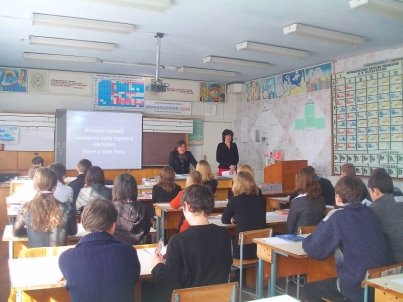
На уроці ми повторимо, перевіримо і систематизуємо знання і вміння з розділу фізики "Електричні явища".
2.Вступне слово вчителя англійської мови.
Good morning students! I am glad to see you again The topic of our today’s lesson is “Electric current and the discoveries of great scientists in this field of science .We are going to speak about great scientific discoveries. We’ll also speak about great scientists as Georg Ohm, Emilie Lenz and James Joule. The stories of their lives are interesting and exciting .You’ll also come across some scientific term and special words which will enlarge your knowledge in English and Physics as well. We’ll also revise English grammar.
But before we start I want to give you a short information about science and scientists. Great discoveries made centuries ago continue to play an important role in the life of people. It is difficult to imagine our life without discoveries and inventions of Newton, Einstein, Faraday and many others who made discoveries in the field of physics, chemistry and different technical sciences. Everything has been done to make our life happier and more comfortable.
II.Оголошення теми та очікуваних результатів.
Учитель фізики. Тема сьогоднішнього уроку:
«Електричний струм та відкриття великих вчених у цьому розділі фізики».
Після цього уроку ви зможете :
- раціонально використовувати час при роботі з науковою й технічною літературою;
- застосовувати знання з електрики в побуті;
- підвищити свій рівень знань з граматичної теми( Passive voice).
ІІІ. Актуалізація знань.
1)Мозковий штурм.
Brain storming.
What is your attitude towards science ? Do you think science play s an important role in the life of people ?
P.1. I think science is important for most people living in the modern world .It is important for world peace and understanding.
P. 2. I believe science is important because it studies the Universe and how to use its possibilities for the benefit of men.
P.3. The study of science also provides people with knowledge of the natural world. and the study of the natural world may help improve life for many people all over the world
P.4. Science is also important for everyone who is affected by modern technology. Many of the things that make our lives easier and better are the results of advances in technology. Such examples include washing machines, dishwashers, microwaves and in the office there are computers, emails etc…
2) Робота на англійській мові з науковою лексикою.
На екрані слайди ( Passive voice).
Electric current / discover / Michael Faraday.
The electric light bulb / invent / Thomas Edison.
The first computer /develop /in 1848 in Britain.
The dishwasher / design / Mrs W. A. Cockran.
Television / invent /1926.
The arc lamp / invent /Yablochkov in 1876.
Lamps using glowing wires / make / as early as 1845 but they didn’t work well because all known wires burned they got white-hot.
The unit for measuring the strength of a current /name /In honour of the great physicist Amper.
The unit for measuring voltage of a current/ name/ in honour of the great physicist Volt.
The unit for measuring the resistance of a current / name/ in honour of the great physicist Ohm.
Olm’s Law /discover/ in 1826.
3)Робота з науковою й технічною термінологією:
(вчитель фізики задає питання, учні відповідають спочатку на українській мові, а потім перекладають на англійську)
- які ви знаєте основні фізичні величини, що використовуються у законах електрики?
(напруга, сила струму, опір)
( Voltage, Current , Resistance)
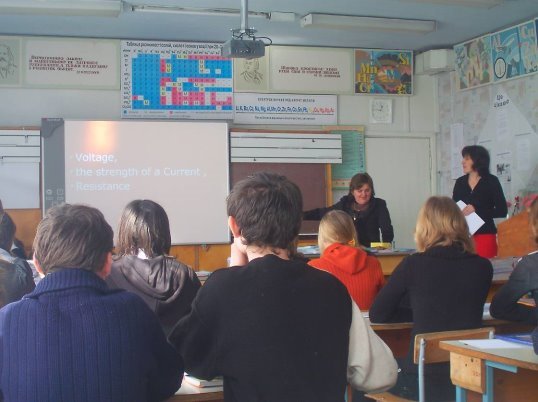
- сформулюйте і запишіть закон Ома для ділянки кола;
(Сила струму прямо пропорційна напрузі і обернено пропорційна опору провідника: ![]() )
)
(The magnitude of the current in a galvanic circuit is directly proportional to the sum of all tensions and indirectly to the total reduced length of the circuit.);
- сформулюйте і запишіть закон Джоуля-Ленца.
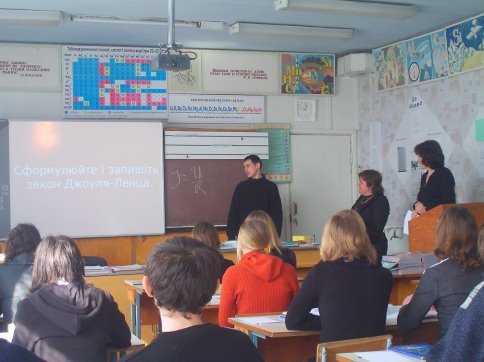
Кількість теплоти, яка виділяється внаслідок проходження струму по провіднику, прямо пропорційна квадрату сили струму, опору провідника та часу протікання струму: ![]()
The amount of heat released during the passage of electric current is directly proportional to the square of the strength of the current conductor resistance and time.
4)Робота з використанням науково – технічного тексту.
Цей етап уроку проводиться у формі бесіди на англійській мові про життя та наукову діяльність учених-фізиків: Г.Ома, Д. Джоуля, Е. Ленца.(див. додаток)
Answer the questions.
1) When and where was George Ohm born ?
2) When did he discover a law known as Ohm’s law ?
3) Where did he teach Physics ?
4) When did Lenz graduate from high school ?
5) What did Lenz present to the Academy of Sciences ?
6) Where did he participate ?
7) When did James Joule invent an electro-magnetic engine ?
8) What did he publish in succeeding years ?
9) When did Joule die ?
IV. Узагальнення і систематизація.
Учням пропонуються задачі на англійській мові. Вони їх перекладають за допомогою технічного словника (див. додаток) і розв`язують.
Розв’язування задач
Задача 1
What length of the aluminium dart (wire) should it be if the area of the cross section of which is 0,1 mm2 and the voltage is 70 mlB and the strength of current in it is 5 mlA
Якої довжини необхідно взяти алюмінієву дротину площею поперечного перерізу 0,1 мм2, щоб при напрузі 70 мВ сила струму в ній дорівнювала 5 мА?
Задача 2
The electric heater has the nickel chrome spiral and the area of the cross section of it is 2,2 mm2 and the length is 11 m. It is connected to the circuit with the voltage of 220 B. Determine the quantity of heat the electric heater will give for 4 hours
Електрокамін, що має спіраль з ніхромового дроту з площею поперечного перерізу 2,2 мм2 і завдовжки 11 м, під'єднано до мережі з напругою 220 В. Визначити кількість теплоти, виділену за 4 години роботи.
V.Рефлексія.
Учителі коментують роботу учнів, їхнє уміння працювати з науковим матеріалом, застосовувати закони електрики при розв’язуванні задач, аналізувати, робити висновки, оцінюють учнів.
Учитель фізики.
Чи досягли ми з вами поставленої мети?
Що на сьогоднішньому уроці вам сподобалося найбільше? Чому?
Що сподобалося менше? Чому?
Підсумкове слово вчителів.
Учитель фізики. Ви розширили свій науково – технічний кругозір, повторили закони електрики і їх практичні застосування побачили можливості розширення фізичних знань, маючи глибокі знання з іноземної мови.
Учитель англійської мови. Ви коротко ознайомилися з життям і діяльністю великих вчених Г. Ома, Д.Джоуля,Е. Ленца, навчились користуватися науково-технічною літературою на англійській мові, розвили навички користування словниками, які містять технічну термінологію.
А зараз ми хочемо побачити ваші враження від уроку. ( На кожній парті знаходяться смайлики з відповідною картинкою-враження)
Оберіть ту, яка найбільше відповідає вашому настрою після уроку.
VI. Домашнє завдання .
Середній - достатній рівень. Підготувати додаткову інформацію про вчених
Г. Ома, Д. Джоуля, Е. Ленца.
Високий рівень. Скласти задачі з використанням законів Ома та Джоуля – Ленца на англійській мові.
Додаток
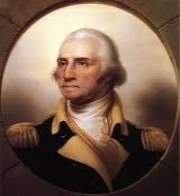 George Simon Ohm
George Simon Ohm
The German physicist George Simon Ohm was the discoverer of the law, named for him, which states the exact relationship of potential and current in electric
condition.
George Ohm was born on March 16, 1789 Erlanger, Bavaria, the oldest of seven children. His father cultivated the obvious mathematical talents of George.
But due to financial difficulties, George left the university of Erlanger in 1806 after three semesters. For the next year and a half he earned his living as private tutor.
But by 1809 he settled in Neufchatel to continue privately with his university studies.
In 1811 he retained to Erlanger and obtained his doctorate. For the next three semesters Ohm taught mathematics at the University of Erlanger.
Following the publication in 1817 of Ohm’s first book, a textbook of Geometry, he received an appointment as teacher of mathematics and physics.
In 1826 he discovered a law or formula what later became known as Ohm’s law. In 1827 he published his most renowned work. It contains the now familiar formula [ I = V/R ] which is followed by the historic statement.
In 1833 he became professor of physics at the Polytechnic School in Nuremberg.
But the real turning point in his life came when the Royal Society of London awarded him the Copley Medal in 1841.
In 1835 he assumed, the chair of higher mathematics at the University of Erlanger.
Later he became inspector of scientific education in the state of Bavaria, and in 1849 as a professor at the University of Munich.
He was working on the manuscript of his textbook on optics when he died on July 6, 1854.
[“The magnitude of the current in a galvanic circuit is directly proportional to the sum of all tensions and indirectly to the total reduced length of the circuit”].
James Prescott Joule
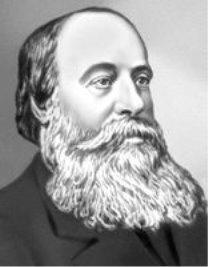
James Prescott Joule English physicist was born on the 24-th of December 1818 at Salford near Manchester. Most of his scientific knowledge was self-taught although he received some instructions from John Dalton in chemistry. This was especially the case with regard to electricity and electro-magnetism the subjects in which his earliest researches were carried out. At the age of nineteen he invented an electro-magnetic engine. In 1840 he was enabled to give a Quantitative statement of the law according to which heat is produced in a conductor by the passage of an electric current. In succeeding years he published a series of valuable researches on the agency of electricity in transformations of energy. One of these contained the first intimation of the achievement with which his name is most widely associated.
It was in a paper read before the British Association at Cork in1843 and entitled “The Calorific Effects of Magneto-electricity and the Mechanical Value of Heat” that he expressed the conviction that whenever mechanical force is expended an exact equivalent of heat is always obtained Q=I² R t .In 1849 he presented to the Royal Society a memoir which together with a history of the subject contained details of a long series of determination. In addition numerous other researches stand to Joule’s credit.
His scientific papers were collected and published by the Physical Society of London. Joule died at Sale on the 11-th of October 1889.
Heinrich Lenz Hristianarch
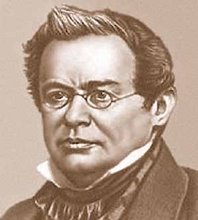 Heinrich Lenz Hristianarch is a famous Russian physicist, academician professor of St. Petersburg University and later its rector. He is known for his remarkable work on electromagnetism and the study of the thermal action of electric current.
Heinrich Lenz Hristianarch is a famous Russian physicist, academician professor of St. Petersburg University and later its rector. He is known for his remarkable work on electromagnetism and the study of the thermal action of electric current.
Lenz was born on February 24th, 1804 in Dorpat (now Jarbu). In 1820 he graduated from high school and enrolled at the University of Dorpat. Independent scientific activity Lenz started as a physicist in the voyage of exploration on the sloop “Enterprise” (1823-1826).
In February, 1828, Lenz presented to the Academy of Sciences report “Physical observations made during a voyage around the world under the command of Captain Otto.” For his efforts, in May 1828, Lenz was elected an associate of the Academy of Physics.
In the years 1829-1830, Lenz studied geophysical studies in Southern Russia. In July 1829, he participated in the first ascent of Mount Elbrus and determined the height of the mountain. He found that the level of the Caspian Sea was 30.5 metres below the Black Sea.
From 1831 to 1836, he studied electromagnetism. Lenz discovered the laws defining the direction of induced current. It is known now as the Lenz Rule. In 1834 Lenz was elected an academician in physics.
In 1842, Lenz opened, irrespective of James Joule’s law, under which the amount of heat released during the passage of electric current is directly proportional to the square of the strength of the current conductor resistance and time. Together with Boris Semenovich Jacobi, Lenz has developed methods for calculating the electromagnets in electric machines and has established the existence in the last “reaction” is omitted.
Технічний словник
Appliance - прилад
The strength of current – сила струм
Electricity - електрика
An invention - винахід
An inventor - винахідник
A theory - теорія
To discover - відкривати
To invent - винаходити
An advance – успіх
An investigation - досліджувати
A research - вивчення
Contribute – робити внесок
Voltage - напруга
Science - наука
Resistance - опір
Cross section – поперечний переріз
Quantity of heat – кількість теплоти


про публікацію авторської розробки
Додати розробку
